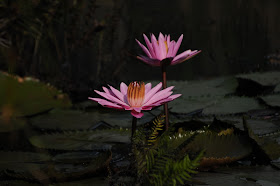For our second day in the Ipoh area, Connie took us to a very special place: a hidden valley in the mountains, reachable only by passing through a substantial cavern - Gua Kek Look Tong, the Cave of Great Happiness.
The entrance, a natural tunnel beneath towering limestone cliffs, is striking enough.
Inside, the cavern has been converted into a Chinese temple, where carved statues of (presumably) wise elders vie for attention with the natural rock formations of the cave roof.
Pass through the cavern, and the valley lies before you - a miniature Shangri-La....
...if, of course, you overlook the rather unsightly factory on the far side of he pond. Still, it's a lovely spot.
The valley floor would seem a bit too manicured for wildlife....
...Despite that fact that the fishes and the turtles in the pond are, apparently, protected.
The turtles, unfortunately, are not one of the increasingly beleaguered Asian natives but an exotic from North America, the Red-eared Slider (Trachemys scripta elegans). Thanks to our habit of farming them in immense numbers and introducing them worldwide (often by simply discarding unwanted pets), Red-eared Sliders have become perhaps the most abundant and widespread wild freshwater turtle in the world. Whether their march across the globe has harmed native turtles outside their own range (either through competition or the spread of exotic diseases) is still a matter of some debate among turtle experts.
The sign of another exotic from North America: the distinctive egg cluster of the introduced Golden Apple Snail (Pomacea canaliculata), a native of South America. In the Americas, Apple Snails of one species or another are food for Snail Kites (Rostrhamus sociabilis), Limpkins (Aramus guarana) and other birds. Does anything eat them here? Not, apparently, human beings, though they were originally introduced to Asia (in Taiwan, in 1980) as a possible food source. People didn't like them, the farms went broke, the snails escaped, and the rest is, alas, history. You can read here about the disastrous result.
Perhaps the water lilies are exotic too? Oh, well, they are certainly attractive!
The most interesting habitat for birds was not the valley floor, but the sheer limestone cliffs that hemmed it in.
Like the turtles and Apple Snails, these birds are exotics. They are Java Sparrows (Padda oryzivora), originally native to Java and Bali, and fairly recent arrivals in Malaysia where birders still get excited about them. I'm not normally a fan of exotics, but I am willing to make an exception in the Java Sparrow's case - not because they are cute or attactive (though they are), but because this once-abundant species, formerly one of the commonest of all cage birds, has undergone a massive population crash in its native land.
Years of intensive trapping, for the pet trade and to provide birds for mass release at Buddhist festivals, combined with persecution among the rice paddies in Java where the birds are regarded as pests, has reduced them to such and extent that Birdlife International now classifies the species as Vulnerable. The exotic populations of Java Sparrow, whether in Malaysia, Hawaii or elsewhere, may have a better shot at long-term survival than the wild poularions from which they sprang.
The Java Sparrow, a confimed haunter of rice paddies, can be hardly said to be a cliffside bird (its specific name, oryzivora, means rice-eating). A much better candidate - though it is quite prepared to consider a building a worthy substitute for a cliff in some parts of its vast range - is the Blue Rock Thrush (Monticola solitarius). The Rock Thrushes around the temple (these are young birds) were remarkably tame, and easy to watch and photograph.
Blue Rock Thrushes range from the Mediterranean clear across Malaysia There are a number of subspecies, in two main categories: all-blue birds like these, and (in the Asian part of its range) birds with chestnut or orange bellies. This is the resident Malaysian subspecies madoci.
A much larger - indeed rather hulking - bird is the Blue Whistling Thrush (Myophonus caeruleus). The Blue Whistling Thrushes of Kek Loong Tong cave have been studied by David Bakewell and Lim Kim Chye in an attempt to sort out the distribution of this species (once thought to be strictly a lowland bird in Malaysia) and the poorly-understood Malaysian Whistling Thrush (Myophonus robinsoni), a highland specialist. It appears that the Blue Whistling Thrush ranges into the highlands too, and that the endemic Malaysian species may be much rarer and more localized than anyone had thought.
This may not look like a typical thrush nest, but it is, in fact, the nest of a Blue Whistling Thrush that has taken up residence inside the cave itself.
Connie's chief interest in bringing us to this area, however, was another species neting on the rocks above the temple. I'm trying to photograph the bird here, using my primitive digiscoping "technique" of holding my video camera up to the eyepiece of Connie's spotting scope and hoping for the best.
Here's the best my own telephoto could do. The bird is a Black-thighed Falconet (Microhierax fringillarius), probably the smallest raptor in the world, ensconced in its cliffside eyrie.
Here are the results of my "digiscoping" - not too bad, actually. Connie has been keeping track of the birds' progress; you can read about it on her blog.
All in all, the valley was a treat. From Ipoh we headed off en route to Kuala Lumpur - but not before thanking Connie for sharing her special birds with us!




























No comments:
Post a Comment